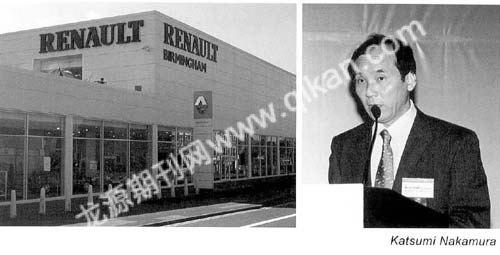Renault Hopes for Renaissance in China
2009-09-03
France-based Renault, which has not gone through good development since its entry into China in 1993, hopes to change this adverse situation with the help of a revival plan.
The French automaker Renault, who was just forced to recall some of its products by the General Administration of Quality Supervision, Inspection and Quarantine of the Peoples Republic of China (AQSIQ), is facing a keynote reform which may change its underperformance in China.
Renault declared to start this reform on July 2. According to the declaration, this reform is a revival plan which will bring an upside turn to the development of Renault in China. In these years, Renault has been facing the danger of being marginalized in China.

Last year, Renault sold 894 vehicles in China. This years targeted sales amount increases to 6000 units. This is only based on the sales performance of Renault in China in the first half of 2009. “We can sell more vehicles in China after the reform. To sell ten thousand vehicles is also possible,” said Robert Chan, President of Renault Greater China. When interviewed by the journalists from China Business News, Robert Chan for the first time revealed some details of the revival plan, including the promotion in sales.
Revival Plan
In the first half of this year, Renault received 3000 orders in China, which surprised the French headquarters very much. In truth, Renault was not well developed in its 16 years in China. After several failures including the breakdown of Sanjiang Renault, its development in China was haunted by a shadow which was hard to get rid of. Its annual sales amount always fluctuated around 1000 units.
The situation didnt take on a betterment trend until last year when Katsumi Nakamura, former president of Dongfeng-Nissan (a joint venture between Nissan and Chinese automaker Dongfeng), took the post of Executive Vice President of Renault, in charge of Renaults businesses in Asia and Africa. Katsumi Nakamura has rich knowledge about the Chinese market.
Robert Chan, who has been Nakamuras underling for a long time, also came to China from the USA after Nakamuras appointment. After that, Chan started a series of reforms. A revival plan, including “four core strategies” and “eight pillars”, began to be formed and matured at that time.
The most important measure is to improve the status of Renault China in the headquarters of Renault. In only half a year, Renault China has increased by two levels. Chan said frankly that the director of Renault China was only a manager before his appointment. “When I took the post, the management level of Renault China has been promoted to the General Manager. After the foundation of Renault Greater China on April 1, 2009, I was promoted to be the Vice President of the corporation and could directly connect with all the vice presidents in the headquarters.”
“From last year the headquarters of Renault placed the Chinese market in the No.1 position and attached unprecedented importance to it,” said Robert Chan. In this March a committee for Chinas market was especially founded in the French headquarters. The chairman is Katsumi Nakamura and the members include all the vice presidents in the headquarters. Chan, as the director of this committee, can communicate directly with the other vice presidents on the corporate development plan in China.
“This is the traditional way of Nissan,” said Chan. Right now, Renault has yielded the French pattern in China; instead, they adopt the Japanese-French mixed pattern. This pattern is featured with the characteristics that the vehicle model is designed by Renault, the finished vehicle is assembled in Korea, some components are produced in Japan, the market focuses on Asia and the headquarters of Renault Greater China is in Beijing. Meanwhile, Nissans management pattern is adopted.
Revival of Channels
Another core of this revival plan is the distribution channels. The changes to the link of sales cut off 32% of the cost of the parts and components in the process of circulation.
According to the previous three-tier distribution system which Renault used for the vehicles exported to China, the general importer in China buys parts and components from France and then sells them to the first-tier distributors with the import prices in addition to a 19% gross profit. The first-tier distributors sell the compnonents to the second-tier distributors with the price 25% higher than the previous one; then the second-tier distributors sell the components to the consumers with another 25% increase in prices. In that way, the consumers have to afford a 69% increase in prices generated in the process of circulation when repairing their cars with imported components. “From now on, we will reduce the cost in the circulation process to less than 30% of the total prices of the components,” said Robert Chan.
The finished vehicles were previously sent back to France from the manufacturing places and were transported to the various distributors in the world. Now, the finished vehicles are transported to the various distributors directly from the manufacturing places.
With the deduction of the cost in the circulation process, Renaults Koleos vehicle, whose former price was 310 thousand yuan (USD 45.37 thousand), now is sold at 268 thousand yuan (USD 39.22 thousand). Out of expectation, this measure was not hated and rebelled by the distributors at different levels. A distributor of imported vehicles in Beijing said that previously the Renault vehicles had high costs and high prices, so the sales performance was not good; now the cost and prices are much lower and the sale, considerably, goes upward. The profit also increases multiply.
Chan called those changes to the distribution link as “the revival of distribution networks”. In the aspect of logistics, he ordered five importers to use the same logistics company instead of the previous five logistics companies for five importers. The charges become more rational and the trade of finished vehicles and components will be settled with the Renminbi. “In that way, the distributors dont have to wait for the change of the exchange rate which will postpone the sales schedule.”
“Five new models will be introduced in China in the second half of this year, most of which are sports cars or racing cars,” said Robert Chan with great confidence in the Chinese imported vehicle market. However, his words about producing vehicles in China are quite cautious: “The increase in the sale of the imported vehicles is the pre-signal of the domestic-made cars. If a kind of vehicle can not see an imports amount of 20,000 units each year, it is not suitable to be produced in China. In addition, the fame and the word of mouth of an imported vehicle should reach a certain level and the distributors must earn profits. Otherwise, the localization of the production can not be realized.”
